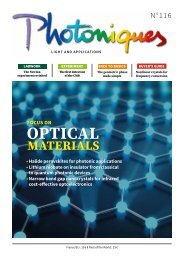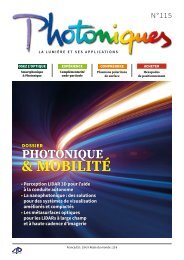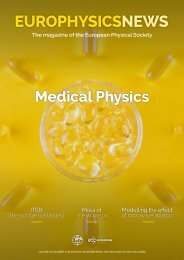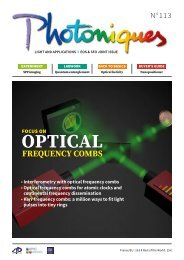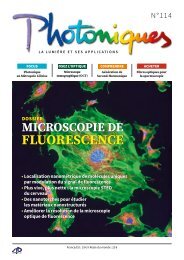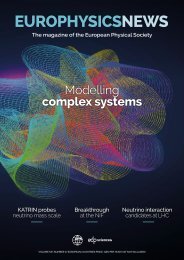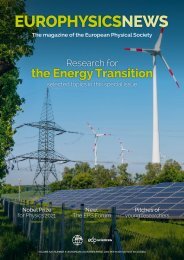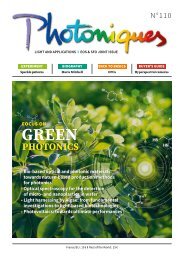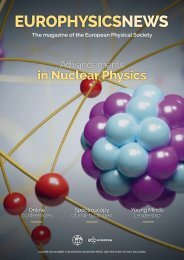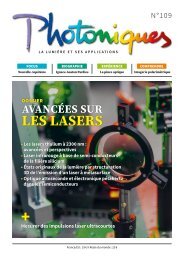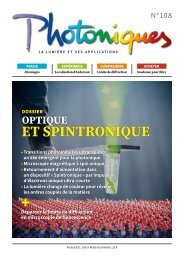Europhysics News 53-4
Europhysics News Quantum Issue
Europhysics News Quantum Issue
Create successful ePaper yourself
Turn your PDF publications into a flip-book with our unique Google optimized e-Paper software.
FEATURES<br />
surface polarons<br />
subsurface TiO 2 layers [4,5]. A way to stabilize surface<br />
polarons is via the deposition of subnanometric silver<br />
(Ag 5 ) clusters [4]. The first step of the Ag 5 –induced surface<br />
polaron formation is the donation of an unpaired<br />
electron from Ag 5 to the TiO 2 surface. As shown in panel<br />
A of Figure 1, the donated electron becomes localized in<br />
one specific 3d orbital lying at the surface, centered at the<br />
Ti atom right below the Ag 5 cluster. After receiving this<br />
extra electron, the Ti 4+ cation becomes a Ti 3+ cation. As<br />
indicated with red arrows in the enlarged view of panel<br />
A of Figure 1, the formation of this Ti 3+ 3d 1 polaronic<br />
state is correlated with the outward movement of the<br />
neighboring oxygen anions. The attractive electrostatic<br />
interaction between the localized Ti 3+ 3d 1 electron and<br />
the positively charged Ag 5 cluster favours the stabilization<br />
of the Ag 5 –induced surface polaron. The pair formed by<br />
the polaronic charge and the positively charged silver<br />
cluster could ease surface redox chemistry.<br />
Evidence of the surface polaron-induced<br />
electron polarization phenomenon<br />
As illustrated in Figure 1, the evidence for the electron<br />
polarization phenomenon has been found in three different<br />
ways as follows [4]:<br />
1) Our first-principles analysis has provided evidence for<br />
the Ag 5 –induced depopulation of 3d(Ti) orbitals, typically<br />
in favour of 2p(O) orbitals, despite the fact that<br />
polarons are characterized by an excess charge (i.e.,<br />
“extra” electrons) trapped at the Ti sites hosting them.<br />
2) A second evidence of the depopulation of 3d(Ti) orbitals<br />
in favour of 2p(O) orbitals has been found through<br />
X-ray absorption near edge structure (XANES) spectroscopy.<br />
This technique is characterized by a high<br />
chemical selectivity. Panel B of Figure 1 shows the<br />
XANES spectra at the Ti K-edge of bare TiO 2 nanoparticles<br />
(shown in black) and Ag 5 –modified TiO 2<br />
nanoparticles (shown in red). The increase of the spectral<br />
feature appearing at ca. 4990 eV for Ag 5 –modified<br />
TiO 2 nanoparticles indicates a charge transfer from<br />
Ti cations to O anions, which results in an on average<br />
decrease of the 3d(Ti) orbitals population.<br />
3) Moreover, a first-principles simulation of the UV-Vis<br />
optical response of the surface polaron provided further<br />
insights into the correlation between the depopulation<br />
of the 3d(Ti) orbitals and the polaron formation<br />
as follows: the excitation of the Ag 5 –TiO 2 system with a<br />
photon energy at the end of the visible region causes the<br />
“jump” of the polaron Ti 3+ 3d 1 electron to the 3d orbitals<br />
of the surface Ti atoms that have suffered depopulation.<br />
Hence, the polaron induces a hole (lack of one electron)<br />
which is extended over the surface Ti atoms in its vicinity<br />
and this hole becomes filled upon photo-excitation<br />
of the polaron. The photo-absorption spectrum is calculated<br />
by weighting the absorbance of the system with<br />
the solar flux [4] (i.e., the absorption of solar energy). It<br />
is shown in panel C of Figure 1, together with the jumping<br />
of an electron from the polaron Ti 3+ 3d 1 state to an<br />
acceptor state formed by many surface 3d(Ti) orbitals.<br />
. FIG. 1: a) Figure illustrating the formation of a surface polaron as a localized 3d 1 electron, and an enlarged view illustrating how the Ti 3+ 3d 1 electron<br />
repels nearby oxygen ions while attracting nearby titanium cations, which, in turn, affects the local electronic structure and causes an electron charge<br />
polarization phenomenon. b) X-ray absorption spectrum at the Ti K-edge of bare TiO 2 (black line) and Ag 5 –modified TiO 2 nanoparticles (red line). c) Theoretical<br />
UV-Vis spectra showing how the polaronic Ti 3+ 3d 1 state is modified when exciting it with a photon energy of about 3.1 eV (marked with a yellow arrow) [4].<br />
08 EPN <strong>53</strong>/4



